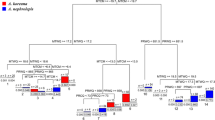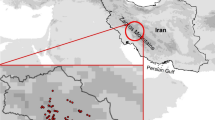Abstract
The questions “Will the environment surrounding moorlands become refugia for a Japanese subalpine coniferous species, Abies mariesii Mast., after climate change?” and “How does the spatial resolution of a species distribution model affect the global warming predictions?” have been discussed in this study. This study was conducted at Hakkoda Mountains, the northern side of Honshu Island, Japan. We constructed 50-m mesh model using a climate variable, two topography variables and two variables relating to moorlands. We applied the model to eight global warming scenarios, including decreasing or non-decreasing scenarios of moorlands. We also constructed a coarse-resolution model at approximately 1-km resolution and compared the model predictions with the fine ones. The results showed that the coarse-resolution model tended to overestimate the range of suitable habitats for A. mariesii. On the other hand, some suitable habitats around moorlands could only be predicted by the fine-resolution model. The fine-resolution model indicated that the peripheries of the moorlands are the most important potential refugia for A. mariesii on Hakkoda Mountains. Although these suitable areas were notable in the +2°C scenario, all suitable habitats completely disappeared in the +4°C scenario. We concluded that it would be effective to conserve the A. mariesii populations around moorlands which are likely to persist after global warming, as well as moorlands themselves. This assessment could only be achieved by fine-resolution models that incorporate non-climatic variables including topography and moorland-related variables with climatic variables. In contrast, a coarse-resolution model overestimated the suitable habitats whilst underestimating potential local refugia. Thus, fine-resolution models are more effective for developing practical adaptation of conservation measures.




Similar content being viewed by others
Abbreviations
- AUC:
-
Area under curve
- CT:
-
Classification tree
- DEM:
-
Digital elevation model
- DWS:
-
Deviance weighted scores
- HAmap:
-
Hakkoda Abies mariesii map
- PRS:
-
Summer (May–September) precipitation
- PRW:
-
Winter (December–March) precipitation
- ROC:
-
Receiver-operating characteristics
- TN:
-
Terminal node
- WI:
-
Warmth index
References
Araújo MB, Thuiller W, Williams PH, Reginster I (2005) Downscaling European species atlas distributions to a finer resolution: implications for conservation planning. Glob Ecol Biogeogr 14:17–30
Ashcroft MB, Chisholm LA, French KO (2009) Climate change at the landscape scale: predicting fine-grained spatial heterogeneity in warming and potential refugia for vegetation. Glob Change Biol 15:656–667
Beckage B, Osborne B, Gavin DG, Pucko C, Siccama T, Perkins T (2008) A rapid upward shift of a forest ecotone during 40 years of warming in the Green Mountains of Vermont. PNAS 105:4197–4202
Charles SP, Bari MA, Kitsios A, Bates BC (2007) Effect of GCM bias on downscaled precipitation and runoff projections for the Serpentine catchment, Western Australia. Int J Climatol 27:1673–1690
Clark LA, Pregibon D (1992) Tree-based models. In: Chambers JM, Hastie TJ (eds) Statistical models in S. Wadsworth & Brooks/Cole Advanced Books & Software, Pacific Grove, pp 377–419
De’ath G, Fabricius KE (2000) Classification and regression trees: a powerful yet simple technique for ecological data analysis. Ecology 81:3178–3192
Efron B (1979) Bootstrap methods: another look at the jackknife. Ann Stat 7:1–26
Geographical Survey Institute (2000) Digital map 50 m grid (elevation). Geographical Survey Institute, Tsukuba
Horikawa M, Tsuyama I, Matsui T, Kominami Y, Tanaka N (2009) Assessing the potential impacts of climate change on the alpine habitat suitability of Japanese stone pine (Pinus pumila). Landsc Ecol 24:115–128
Huntley B, Berry PM, Cramer W, McDonald AP (1995) Special paper: modelling present and potential future ranges of some European higher plants using climate response surfaces. J Biogeogr 22:967–1001
IPCC (2007) In: Parry ML, Canziani OF, Palutikof JP, Linden PJ, Hanson CE (eds) Climate Change 2007: impacts, adaptation and vulnerability. Contribution of Working Group II to the fourth assessment report of the intergovernmental panel on climate change. Cambridge University Press, Cambridge, p 976
Iverson LR, Prasad AM (1998) Predicting abundance of 80 tree species following climate change in the eastern United States. Ecol Monogr 68:465–485
Japan Map Center (1998) Numerical map user guide, 2nd version. Japan Map Center, Tokyo
Japan Meteorological Agency (1996) Climate normals for Japan. Japan Meteorological Agency, Tokyo
Kaji M (1982) Studies on the ecological geography of subalpine conifers: distribution pattern of Abies mariesii in relation to the effect of climate in the postglacial warm period. Bull Tokyo Univ For 72:31–120
Kira T (1977) A climatological interpretation of Japanese vegetation zone. In: Miyawaki A, Tuexen R (eds) Vegetation science and environmental protection. Maruzen, Tokyo, pp 21–30
Koike K, Toshikazu T, Chinzei K, Miyagi T (2005) Regional geomorphology of Japanese Islands, geomorphology of Tohoku region, vol 3. University of Tokyo Press, Tokyo
Leitinger G, Höller P, Tasser E, Walde J, Tappeiner U (2008) Development and validation of a spatial snow-glide model. Ecol Model 211:363–374
Lenoir J, Gegout JC, Marquet PA, de Ruffray P, Brisse H (2008) A significant upward shift in plant species optimum elevation during the 20th century. Science 320:1768–1771
Lobo JM, Jiménez-Valverde A, Real R (2008) AUC: a misleading measure of the performance of predictive distribution models. Global Ecol Biogeogr 17:145–151
Marschner H (1991) Mechanisms of adaptation of plants to acid soils. Plant Soil 134:1–20
Matsui T, Nakaya T, Yagihashi T, Taoda H, Tanaka N (2004a) Comparing the accuracy of predictive distribution models for Fagus crenata forests in Japan. Jpn J For Environ 46:93–102
Matsui T, Yagihashi T, Nakaya T, Taoda H, Yoshinaga S, Daimaru H, Tanaka N (2004b) Probability distributions, vulnerability and sensitivity in Fagus crenata forests following predicted climate changes in Japan. J Veg Sci 15:605–614
Matsui T, Takahashi K, Tanaka N, Hijioka Y, Horikawa M, Yagihashi T, Harasawa H (2009) Evaluation of habitat sustainability and vulnerability for beech (Fagus crenata) forests under 110 hypothetical climatic change scenarios in Japan. Appl Veg Sci 12:328–339
Mearns LO, Rosenzweig C, Goldberg R (1997) Mean and variance change in climate scenarios: methods, agricultural applications, and measures of uncertainty. Clim Change 35:367–396
Metz CE (1978) Basic principles of ROC analysis. Semin Nucl Med 8:283–298
Morin X, Thuiller W (2009) Comparing niche- and process-based models to reduce prediction uncertainty in species range shifts under climate change. Ecology 90:1301–1313
Morita Y (1985) The vegetational history of the subalpine zone in northeast Japan II. The Hachimantai mountains. Jpn J Ecol 35:411–420
Murach D, Ulrich B (1988) Destabilization of forest ecosystems by acid deposition. GeoJournal 17:253–259
Nogami M (1994) Thermal condition of the forest vegetation zones and their potential distribution under different climates in Japan. J Geogr 103:886–897
Nogami M, Ohba H (1991) Japanese vegetation seen from warmth index. Kagaku 61:39–49
Pearce J, Ferrier S (2000) Evaluating the predictive performance of habitat models developed using logistic regression. Ecol Model 133:225–245
Pearson RG, Dawson TP, Liu C (2004) Modelling species distributions in Britain: a hierarchical integration of climate and land-cover data. Ecography 27:285–298
R Development Core Team (2008) R: a language and environment for statistical computing. R Foundation for Statistical Computing, Vienna
Shidei T (1956) A view on the cause of the lack of coniferous forest zone in subalpine area on some mountains in the Japan sea side. J Jpn For Soc 38:356–358
Smith W, Germino M, Johnson D, Reinhardt K (2009) The altitude of alpine treeline: a bellwether of climate change effects. Bot Rev 75:163–190
Sugita H (1990) Consideration on the history of the development of the Abies mariesii forest during postglacial time based on its distributional character. Jpn J Hist Bot 6:31–37
Sugita H (1992) Ecological geography of the range of the Abies mariesii forest in northeast Honshu, Japan, with special reference to the physiographic conditions. Ecol Res 7:119–132
Swets JA (1988) Measuring the accuracy of diagnostic systems. Science 240:1285–1293
Tanaka N, Nakazono E, Tsuyama I, Matsui T (2009) Assessing impact of climate warming on potential habitats of ten conifer species in Japan. Glob Environ Res 14:153–164
Thuiller W, Araújo MB, Lavorel S (2003) Generalized models vs. classification tree analysis: predicting spatial distributions of plant species at different scales. J Veg Sci 14:669–680
Thuiller W, Lavorel S, Araújo MB, Sykes MT, Prentice IC (2005) Climate change threats to plant diversity in Europe. PNAS 102:8245–8250
Trivedi MR, Berry PM, Morecroft MD, Dawson TP (2008) Spatial scale affects bioclimate model projections of climate change impacts on mountain plants. Glob Change Biol 14:1089–1103
Tsuyama I, Nakao K, Matsui T, Higa M, Horikawa M, Kominami Y, Tanaka N (2011) Climatic controls of a keystone understory species, Sasamorpha borealis, and an impact assessment of climate change in Japan. Ann For Sci 68:689–699
Yamanaka M, Sugawara K, Ishikawa S (1988) A historical study of the Abies mariesii forest found in the montane zone in the south Hakkoda mountains, northeast Japan. Jpn J Ecol 38:147–157
Yonekura K, Kajita T (2003) BG Platns wamei-gakumei (Japanese–Latin) index (YList). http://bean.bio.chiba-u.jp/bgplants/index.html (in Japanese). Accessed 28 July 2011
Zimmermann NE, Kienast F (1999) Predictive mapping of alpine grasslands in Switzerland: species versus community approach. J Veg Sci 10:469–482
Zweig MH, Campbell G (1993) Receiver-operating characteristic (ROC) plots: a fundamental evaluation tool in clinical medicine. Clin Chem 39:561–577
Acknowledgments
The authors are grateful to K. Yonekura for advice about species identification as well as K. Hikosaka, T. Sasaki, C. Kamiyama, A. Yoshida, H. Daimaru and M. Yasuda for their valuable suggestions. This study was supported by the Global Environment Research Fund (grant Nos. F-092, S-4 and S-8) of the Ministry of the Environment, Japan.
Author information
Authors and Affiliations
Corresponding author
Additional information
Nomenclature: Yonekura and Kajita (2003).
Electronic supplementary material
Below is the link to the electronic supplementary material.
Rights and permissions
About this article
Cite this article
Shimazaki, M., Tsuyama, I., Nakazono, E. et al. Fine-resolution assessment of potential refugia for a dominant fir species (Abies mariesii) of subalpine coniferous forests after climate change. Plant Ecol 213, 603–612 (2012). https://doi.org/10.1007/s11258-012-0025-5
Received:
Accepted:
Published:
Issue Date:
DOI: https://doi.org/10.1007/s11258-012-0025-5




